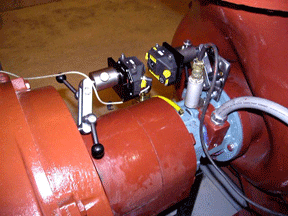“Thermal growth” often refers to the change in machinery positions as a machine runs from startup to operating conditions (or vice versa). Machinery positional change can also be caused by dynamic forces, pipe stress, and other factors. Compensating for thermal growth is necessary because the machine will be misaligned during operating conditions if it is not.
We offer two methods for the measurement of thermal growth. One is a “snapshot” method and the other is continuous monitoring. Our current line of M3 brackets provides an accurate and easy-to-use method to take a measurement using the “snapshot” method.

A reading is taken by mounting the sensors and rotating both brackets to create a “virtual” shaft alignment reading across the coupling. Measurement is taken before and after the machine is running. The difference between the two measurements is the change in the alignment.
M3 brackets provide a cost-effective method of measuring thermal growth because they can be used with any of our current shaft alignment product lines. It should not be confused with the static “hot and cold alignment check” (where shaft alignment equipment is mounted on the shaft and readings are taken conventionally, before and after startup, on a machine that is not running). Assuming that the bracket was never bumped or moved during the measurement, the results are much more accurate than those obtained by the static “hot and cold alignment check”. Below are typical results one could expect to see from startup to running conditions:
Vertical Offset: -24.4 mil
Vertical Angularity: 15.2 mil/10”
Horizontal Offset: -12.3 mil
Horizontal Angularity: 7.5 mil
You will probably notice that a significant amount of angularity exists, which goes against a lot of assumptions in thermal growth calculation methods where it is assumed that the machine will grow an even amount. When taking thermal growth readings using the “snapshot” method, you will want to confirm (establish repeatability) the measurement. This can be accomplished by taking another reading on cool down. The difference in the cold-to-hot and the hot-to-cold readings should be very similar, but with the opposite sign. This is an essential practice because you are making the assumption that the bracket was never accidentally moved or bumped. In Part 2 of this article, we will show how “continuous monitoring” can provide a more complete and accurate picture of what is going on with thermal growth.
Filed under:
Alignment by Daus Studenberg CRL
